Remarkable Thermal Performance Enhancement of Micro Heat Pipes with Graphene-Nanoplatelet Nano-Wicks
Abstract
1. Introduction
2. Materials and Methods
2.1. Fabrication of MHP with GNP Nano-Wicks
2.2. Experimental Setup
2.3. Evaluation of Water Permeation in GNP-Coatings
2.4. Characterization of GNP Coatings
2.5. Thermal Performance Evaluation of MHP
3. Results and Discussion
3.1. Wetting Behavior of GNP Coatings
3.2. Characterization Analysis of GNPs
4. Discussion
5. Conclusions
- (1)
- The hydrophobic, atomically smooth carbon walls of GNPs nanostructures provide a network of nanocapillaries that allows water molecules to intercalate among the graphene layers and travel in a near-frictionless manner.
- (2)
- Together with the attraction force of the oxygenated functional groups, a series of hydrophobic and hydrophilic surfaces are formed that significantly improve the water circulation rate.
- (3)
- At the same time, the intercalation of water molecules encourages the formation of a water-thin film that leads to a larger heat-transfer surface area. In turn, film-wise evaporation occurs and much higher latent heat is absorbed and transferred to the condenser section.
- (4)
- Simultaneously, the nanocapillary pressure along with the oxygenated functional group drives the condensate back to the evaporator section in a continuous and efficient manner. The GNP nano-wicks provide significant enhancement in the key processes of an MHP, namely the evaporation and the condensate circulation, leading to a remarkable improvement in its heat transfer efficiency which is evidently dependent on the thickness of the GNP nano-wicks.
Author Contributions
Funding
Data Availability Statement
Conflicts of Interest
References
- Balandin, A.A.; Ghosh, S.; Bao, W.; Calizo, I.; Teweldebrhan, D.; Miao, F.; Lau, C.N. Superior thermal conductivity of single-layer graphene. Nano Lett. 2008, 8, 902–907. [Google Scholar] [CrossRef] [PubMed]
- Tarannum, F.; Muthaiah, R.; Annam, R.S.; Gu, T.; Garg, J. Effect of alignment on enhancement of thermal conductivity of polyethylene–graphene nanocomposites and comparison with effective medium theory. Nanomaterials 2020, 10, 1291. [Google Scholar] [CrossRef] [PubMed]
- Wu, L.; Sun, X.; Gong, F.; Luo, J.; Yin, C.; Sun, Z.; Xiao, R. Enhanced thermal transport properties of graphene/SiC heterostructures on nuclear reactor cladding material: A molecular dynamics insight. Nanomaterials 2022, 12, 894. [Google Scholar] [CrossRef]
- Gao, J.; Yan, Q.; Tan, X.; Lv, L.; Ying, J.; Zhang, X.; Yang, M.; Du, S.; Wei, Q.; Xue, C.; et al. Surface modification using polydopamine-coated liquid metal nanocapsules for improving performance of graphene paper-based thermal interface materials. Nanomaterials 2021, 11, 1236. [Google Scholar] [CrossRef] [PubMed]
- Ghosh, S.; Calizo, I.; Teweldebrhan, D.; Pokatilov, E.P.; Nika, D.L.; Balandin, A.A.; Bao, W.; Miao, F.; Lau, C.N. Extremely high thermal conductivity of graphene: Prospects for thermal management applications in nanoelectronic circuits. Appl. Phys. Lett. 2008, 92, 2008–2010. [Google Scholar] [CrossRef]
- Tong, W.L.; Hung, Y.M.; Yu, H.; Tan, M.K.; Ng, B.T.; Tan, B.T.; Wu, H.A.; Soh, A.K. Ultrafast water permeation in graphene nanostructures anomalously enhances two-phase heat transfer. Adv. Mater. Interfaces 2018, 5, 1800286. [Google Scholar] [CrossRef]
- Gan, J.S.; Yu, H.; Tan, M.K.; Soh, A.K.; Wu, H.A.; Hung, Y.M. Performance enhancement of graphene-coated micro heat pipes for light-emitting diode cooling. Int. J. Heat Mass Transf. 2020, 154, 119687. [Google Scholar] [CrossRef]
- Sudhindra, S.; Kargar, F.; Balandin, A.A. Noncured graphene thermal interface materials for high-power electronics: Minimizing the thermal contact resistance. Nanomaterials 2021, 11, 1699. [Google Scholar] [CrossRef]
- Ng, V.O.; Yu, H.; Wu, H.A.; Hung, Y.M. Thermal performance enhancement and optimization of two-phase closed thermosyphon with graphene-nanoplatelets coatings. Energy Convers. Manag. 2021, 236, 114039. [Google Scholar] [CrossRef]
- Lim, C.S.; Sia, G.D.; Hung, Y.M. Extraordinary enhancement of nucleate pool boiling on intrinsically biphilic graphene nanostructured surfaces. Appl. Therm. Eng. 2023, 218, 119354. [Google Scholar] [CrossRef]
- Pop, E.; Varshney, V.; Roy, A.K. Thermal properties of graphene: Fundamentals and applications. MRS Bull. 2012, 37, 1273–1281. [Google Scholar] [CrossRef]
- Gan, J.S.; Hung, Y.M. Thermal analysis of Al2O3/water nanofluid-filled micro heat pipes. RSC Adv. 2015, 5, 26716–26725. [Google Scholar] [CrossRef]
- Hung, Y.M.; Tio, K.-K. Thermal analysis of a water-filled micro heat pipe with phase- change interfacial resistance. J. Heat Transf. 2012, 134, 112901. [Google Scholar] [CrossRef]
- Gan, J.S.; Sia, T.S.; Hung, Y.M.; Chin, J.K. Dryout analysis of overloaded microscale capillary-driven two-phase heat transfer devices. Int. Commun. Heat Mass Transf. 2016, 76, 162–170. [Google Scholar] [CrossRef]
- Sia, G.D.; Tan, M.K.; Chen, G.M.; Hung, Y.M. Performance enhancement of subcooled flow boiling on graphene nanostructured surfaces with tunable wettability. Case Stud. Therm. Eng. 2021, 27, 101283. [Google Scholar] [CrossRef]
- Ting, T.W.; Hung, Y.M.; Guo, N. Viscous dissipation effect on streamwise entropy generation of nanofluid flow in microchannel heat sinks. J. Energy Resour. Technol. 2016, 138, 052002. [Google Scholar] [CrossRef]
- Ting, T.W.; Hung, Y.M.; Guo, N. Viscous dissipative nanofluid convection in asymmetrically heated porous microchannels with solid-phase heat generation. Int. Commun. Heat Mass Transf. 2015, 68, 236–247. [Google Scholar] [CrossRef]
- Chang, F.L.; Hung, Y.M. The coupled effects of working fluid and solid wall on thermal performance of micro heat pipes. Int. J. Heat Mass Transf. 2014, 73, 76–87. [Google Scholar] [CrossRef]
- Lay, K.K.; Cheong, B.M.Y.; Tong, W.L.; Tan, M.K.; Hung, Y.M. Effective micro-spray cooling for light-emitting diode with graphene nanoporous layers. Nanotechnology 2017, 28, 164003. [Google Scholar] [CrossRef]
- Lim, Y.S.; Hung, Y.M. Anomalously enhanced light-emitting diode cooling via nucleate boiling using graphene-nanoplatelets coatings. Energy Convers. Manag. 2021, 244, 11452. [Google Scholar] [CrossRef]
- Yong, K.Y.; Chan, Y.K.; Lau, E.V.; Hung, Y.M. Effective passive phase-change light-emitting diode cooling system using graphene nanoplatelets coatings. Case Stud. Therm. Eng. 2022, 31, 101795. [Google Scholar] [CrossRef]
- Allred, T.P.; Weibel, J.A.; Garimella, S.V. Enabling highly effective boiling from superhydrophobic surfaces. Phys. Rev. Lett. 2018, 120, 174501. [Google Scholar] [CrossRef]
- Tong, W.L.; Ong, W.J.; Chai, S.P.; Tan, M.K.; Hung, Y.M. Enhanced evaporation strength through fast water permeation in graphene-oxide deposition. Sci. Rep. 2015, 5, 11896. [Google Scholar] [CrossRef] [PubMed]
- Kim, J.M.; Kim, T.; Kim, J.; Kim, M.H.; Ahn, H.S. Effect of a graphene oxide coating layer on critical heat flux enhancement under pool boiling. Int. J. Heat Mass Transf. 2014, 77, 919–927. [Google Scholar] [CrossRef]
- Choi, G.; Shim, D.I.; Lee, D.; Kim, B.S.; Cho, H.H. Enhanced nucleate boiling using a reduced graphene oxide-coated micropillar. Int. Commun. Heat Mass Transf. 2019, 109, 104331. [Google Scholar] [CrossRef]
- Chu, B.; Fang, C.; Zheng, F.; Cheng, W.; Wang, R.; Zhang, W.; Tao, J.; Huai, L.; Tao, P.; Song, C.; et al. Hybrid graphene oxide/crumpled graphene film via subcooled boiling-induced self-assembly for highly efficient boiling heat transfer. Mater. Today Energy 2021, 22, 100868. [Google Scholar] [CrossRef]
- Lay, K.K.; Ong, J.S.; Yong, K.Y.; Tan, M.K.; Hung, Y.M. Nucleate pool boiling enhancement by ultrafast water permeation in graphene-nanostructure. Int. Commun. Heat Mass Transf. 2019, 101, 26–34. [Google Scholar] [CrossRef]
- Goodarzi, M.; Tlili, I.; Moria, H.; Cardoso, E.M.; Alkanhal, T.A.; Anqi, A.E.; Safaei, M.R. Boiling flow of graphene nanoplatelets nano-suspension on a small copper disk. Powder Technol. 2021, 377, 10–19. [Google Scholar] [CrossRef]
- Ng, V.O.; Hong, X.Y.; Yu, H.; Wu, H.A.; Hung, Y.M. Anomalously enhanced thermal performance of micro heat pipes coated with heterogeneous superwettable graphene nanostructures. Appl. Energy 2023, 326, 119994. [Google Scholar] [CrossRef]
- Rainho, N.A.; Oliveira, J.L.G.; Passos, J.C. Heat transfer coefficient and critical heat flux during nucleate pool boiling of water in the presence of nanoparticles of alumina, maghemite and CNTs. Appl. Therm. Eng. 2017, 111, 1493–1506. [Google Scholar] [CrossRef]
- Sezer, N.; Khan, S.A.; Koç, M. Amelioration of the pool boiling heat transfer performance via self-assembling of 3D porous graphene/carbon nanotube hybrid film over the heating surface. Int. J. Heat Mass Transf. 2019, 145, 118732. [Google Scholar] [CrossRef]
- Zhao, H.; Dash, S.; Dhillon, N.S.; Kim, S.; Lettiere, B.; Varanasi, K.K.; Hart, A.J. Microstructured ceramic-coated carbon nanotube surfaces for high heat flux pool boiling. ACS Appl. Nano Mater. 2019, 2, 5538–5545. [Google Scholar] [CrossRef]
- Mao, L.; Hu, X.; Zhou, W. Self-assembly carbon nanotubes nanoporous coating with great durability for highly efficient boiling heat transfer. Carbon 2020, 164, 184–197. [Google Scholar] [CrossRef]
- Ng, E.C.J.; Kueh, T.C.; Wang, X.; Soh, A.K.; Hung, Y.M. Anomalously enhanced thermal performance of carbon-nanotubes coated micro heat pipes. Energy 2021, 214, 118909. [Google Scholar] [CrossRef]
- Guo, S.; Chen, J.; Zhang, Y.; Liu, J. Graphene-based films: Fabrication, interfacial modification, and applications. Nanomaterials 2021, 11, 2539. [Google Scholar] [CrossRef]
- Mahmoud, K.A.; Mansoor, B.; Mansour, A.; Khraisheh, M. Functional graphene nanosheets: The next generation membranes for water desalination. Desalination 2015, 356, 208–225. [Google Scholar] [CrossRef]
- Pedico, A.; Fontana, M.; Bianco, S.; Kara, S.; Periolatto, M.; Carminati, S.; Pirri, C.F.; Tresso, E.; Lamberti, A. Graphene oxide membranes for trace hydrocarbon contaminant removal from aqueous solution. Nanomaterials 2020, 10, 2242. [Google Scholar] [CrossRef] [PubMed]
- Baskoro, F.; Kumar, S.R.; Lue, S.J. Grafting thin layered graphene oxide onto the surface of nonwoven/PVDF-PAA composite membrane for efficient dye and macromolecule separations. Nanomaterials 2020, 10, 792. [Google Scholar] [CrossRef]
- Andreeva, D.V.; Trushin, M.; Nikitina, A.; Costa, M.C.F.; Cherepanov, P.V.; Holwill, M.; Chen, S.; Yang, K.; Chee, S.W.; Mirsaidov, U.; et al. Two-dimensional adaptive membranes with programmable water and ionic channels. Nat. Nanotechnol. 2021, 16, 174–180. [Google Scholar] [CrossRef]
- Yang, K.; Huang, L.-J.; Wang, Y.-X.; Du, Y.-C.; Zhang, Z.-J.; Wang, Y.; Kipper, M.J.; Belfiore, L.A.; Tang, J.-G. Graphene oxide nanofiltration membranes containing silver nanoparticles: Tuning separation efficiency via nanoparticle size. Nanomaterials 2020, 10, 454. [Google Scholar] [CrossRef]
- Wang, Z.; Ma, C.; Xu, C.; Sinquefield, S.A.; Shofner, M.L.; Nair, S. Graphene oxide nanofiltration membranes for desalination under realistic conditions. Nat. Sustain. 2021, 4, 402–408. [Google Scholar] [CrossRef]
- Chae, J.; Lim, T.; Cheng, H.; Hu, J.; Kim, S.; Jung, W. Graphene oxide and carbon nanotubes-based polyvinylidene fluoride membrane for highly increased water treatment. Nanomaterials 2021, 11, 2498. [Google Scholar] [CrossRef] [PubMed]
- Zhang, W.; Xu, H.; Xie, F.; Ma, X.; Niu, B.; Chen, M.; Zhang, Y.; Long, D. General synthesis of ultrafine metal oxide/reduced graphene oxide nanocomposites for ultrahigh-flux nanofiltration membrane. Nat. Commun. 2022, 13, 471. [Google Scholar] [CrossRef] [PubMed]
- Lim, C.S.; Kueh, T.C.; Soh, A.K.; Hung, Y.M. Engineered superhydrophilicity and superhydrophobicity of graphene-nanoplatelet coatings via thermal treatment. Powder Technol. 2020, 364, 88–97. [Google Scholar] [CrossRef]
- Lim, C.S.; Lau, E.V.; Kee, K.E.; Hung, Y.M. A comparative study of superhydrophobicity of 0D/1D/2D thermally functionalized carbon nanomaterials. Ceram. Int. 2021, 47, 30331–30342. [Google Scholar] [CrossRef]
- Kueh, T.C.; Chew, S.H.; Soh, A.K.; Hung, Y.M. Investigation of the influence of the location of oxygenated functional groups in graphene nanostructures on water permeation via molecular dynamics simulations. Appl. Surf. Sci. 2023, 609, 155414. [Google Scholar] [CrossRef]
- Nair, R.R.; Wu, H.A.; Jayaram, P.N.; Grigorieva, I.V.; Geim, A.K. Unimpeded permeation of water through helium-leak-tight graphene-based membranes. Science 2012, 335, 442. [Google Scholar] [CrossRef]
- Lim, E.; Hong, X.Y.; Tan, M.K.; Yu, H.; Wu, H.A.; Hung, Y.M. Distinctive evaporation characteristics of water and ethanol on graphene nanostructured surfaces. Int. J. Heat Mass Transf. 2022, 183, 122174. [Google Scholar] [CrossRef]
- Jiang, L.; Ling, J.; Jiang, L.; Tang, Y.; Li, Y.; Zhou, W.; Gao, J. Thermal performance of a novel porous crack composite wick heat pipe. Energy Convers. Manag. 2014, 81, 10–18. [Google Scholar] [CrossRef]
- Schampheleire, S.D.; Kerpel, K.D.; Deruyter, T.; Jaeger, P.D.; Paepe, M.D. Experimental study of small diameter fibres as wick material for capillary-driven heat pipes. Appl. Therm. Eng. 2015, 78, 258–267. [Google Scholar] [CrossRef]
- Xin, F.; Ma, T.; Wang, Q. Thermal performance analysis of flat heat pipe with graded mini-grooves wick. Appl. Energy 2018, 228, 2129–2139. [Google Scholar] [CrossRef]
- Zhu, M.; Huang, J.; Song, M.; Hu, Y. Thermal performance of a thin flat heat pipe with grooved porous structure. Appl. Therm. Eng. 2020, 173, 115215. [Google Scholar] [CrossRef]
- Huang, G.; Li, W.; Zhong, G.; Abdulshaheed, A.A.; Li, C. Optimizing L-shaped heat pipes with partially-hybrid mesh-groove wicking structures. Int. J. Heat Mass Transf. 2021, 170, 120926. [Google Scholar] [CrossRef]
- Solomon, A.B.; Mahto, A.K.; Joy, R.C.; Rajan, A.A.; Jayprakash, D.A.; Dixit, A.; Sahay, A. Application of bio-wick in compact loop heat pipe. Appl. Therm. Eng. 2020, 169, 114927. [Google Scholar] [CrossRef]
- Jo, H.S.; An, S.; Nguyen, X.H.; Kim, Y.I.; Bang, B.-H.; James, S.C.; Choi, J.; Yoon, S.S. Modifying capillary pressure and boiling regime of micro-porous wicks textured with graphene oxide. Appl. Therm. Eng. 2018, 128, 1605–1610. [Google Scholar] [CrossRef]
- Zhou, Y.; Cui, X.; Weng, J.; Shi, S.; Han, H.; Chen, C. Experimental investigation of the heat transfer performance of an oscillating heat pipe with graphene nanofluids. Powder Technol. 2018, 332, 371–380. [Google Scholar] [CrossRef]
- Li, Z.; Sarafraz, M.M.; Mazinani, A.; Moria, H.; Tlili, I.; Alkanhal, T.A.; Goodarzi, M.; Safaei, M.R. Operation analysis, response and performance evaluation of a pulsating heat pipe for low temperature heat recovery. Energy Convers. Manag. 2020, 222, 113230. [Google Scholar] [CrossRef]
- Liu, Y.; Zheng, R.; Tian, T.; Li, J. Characteristics of thermal storage heat pipe charged with graphene nanoplatelets enhanced organic phase change material. Energy Convers. Manag. 2022, 267, 115902. [Google Scholar] [CrossRef]
- Wolfram Research, Inc. Mathematica, Version 13.0.0.; Wolfram Research, Inc.: Champaign, IL, USA, 2021. [Google Scholar]
- Kudin, K.N.; Ozbas, B.; Schniepp, H.C.; Prud’homme, R.K.; Aksay, I.A.; Car, R. Raman Spectra of Graphite Oxide and Functionalized Graphene Sheets. Nano Lett. 2008, 8, 36–41. [Google Scholar] [CrossRef]
- Liu, J.; Li, P.; Zheng, H. Review on techniques for thermal characterization of graphene and related 2D materials. Nanomaterials 2021, 11, 2787. [Google Scholar] [CrossRef]
- Radha, B.; Esfandiar, A.; Wang, F.C.; Rooney, A.P.; Gopinadhan, K.; Keerthi, A.; Mishchenko, A.; Janardanan, A.; Blake, P.; Fumagalli, L.; et al. Molecular trans- port through capillaries made with atomic-scale precision. Nature 2016, 538, 222–225. [Google Scholar] [CrossRef]
- Goh, J.Y.H.; Hung, Y.M.; Tan, M.K. Extraordinarily enhanced evaporation of water droplets on graphene-nanostructure d coate d surfaces. Int. J. Heat Mass Transf. 2020, 163, 120396. [Google Scholar] [CrossRef]
- Zhong, W.R.; Zhang, M.P.; Ai, B.Q.; Zheng, D.Q. Chirality and thickness-dependent thermal conductivity of few-layer graphene: A molecular dynamics study. Appl. Phys. Lett. 2011, 98, 113107. [Google Scholar] [CrossRef]
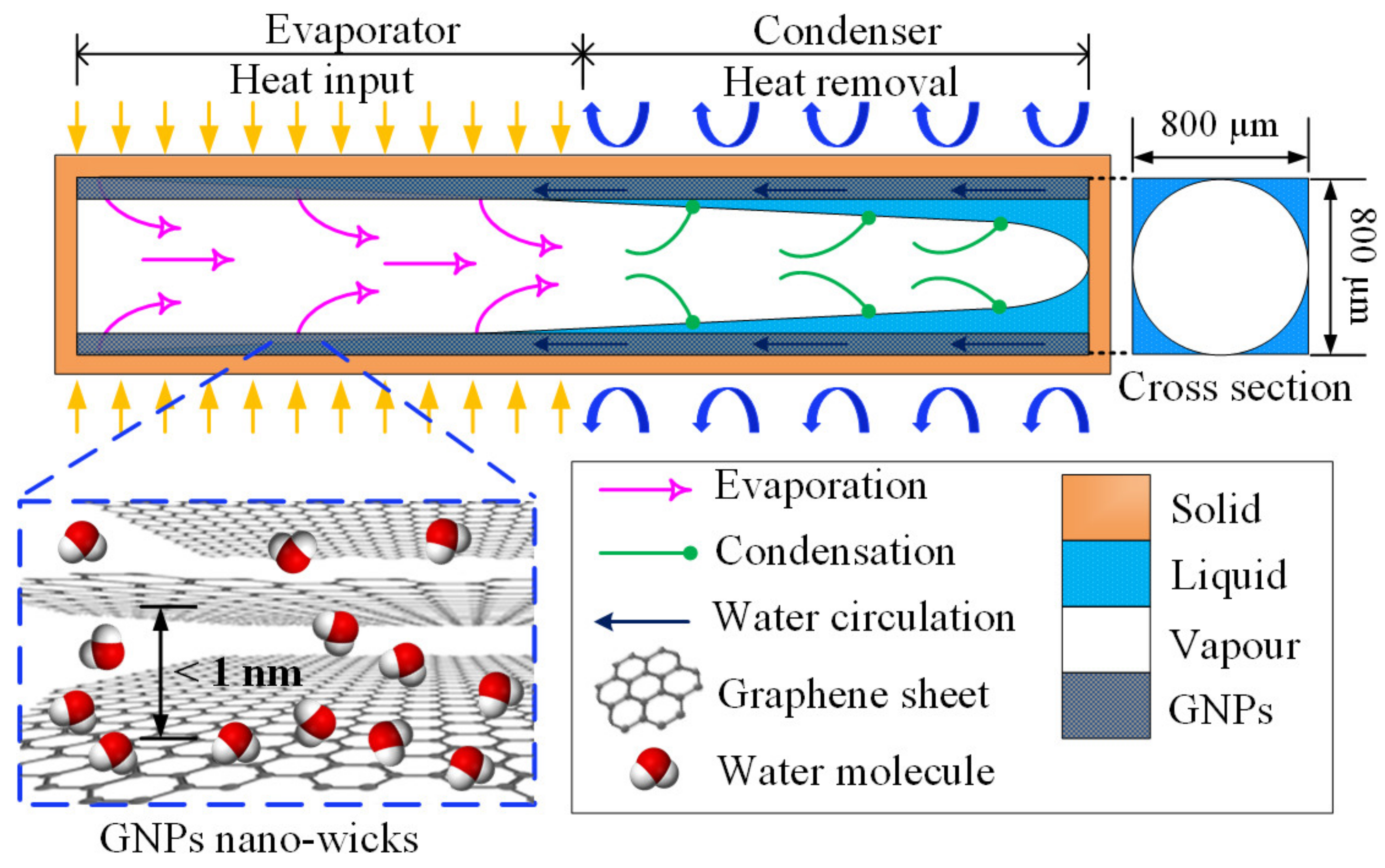
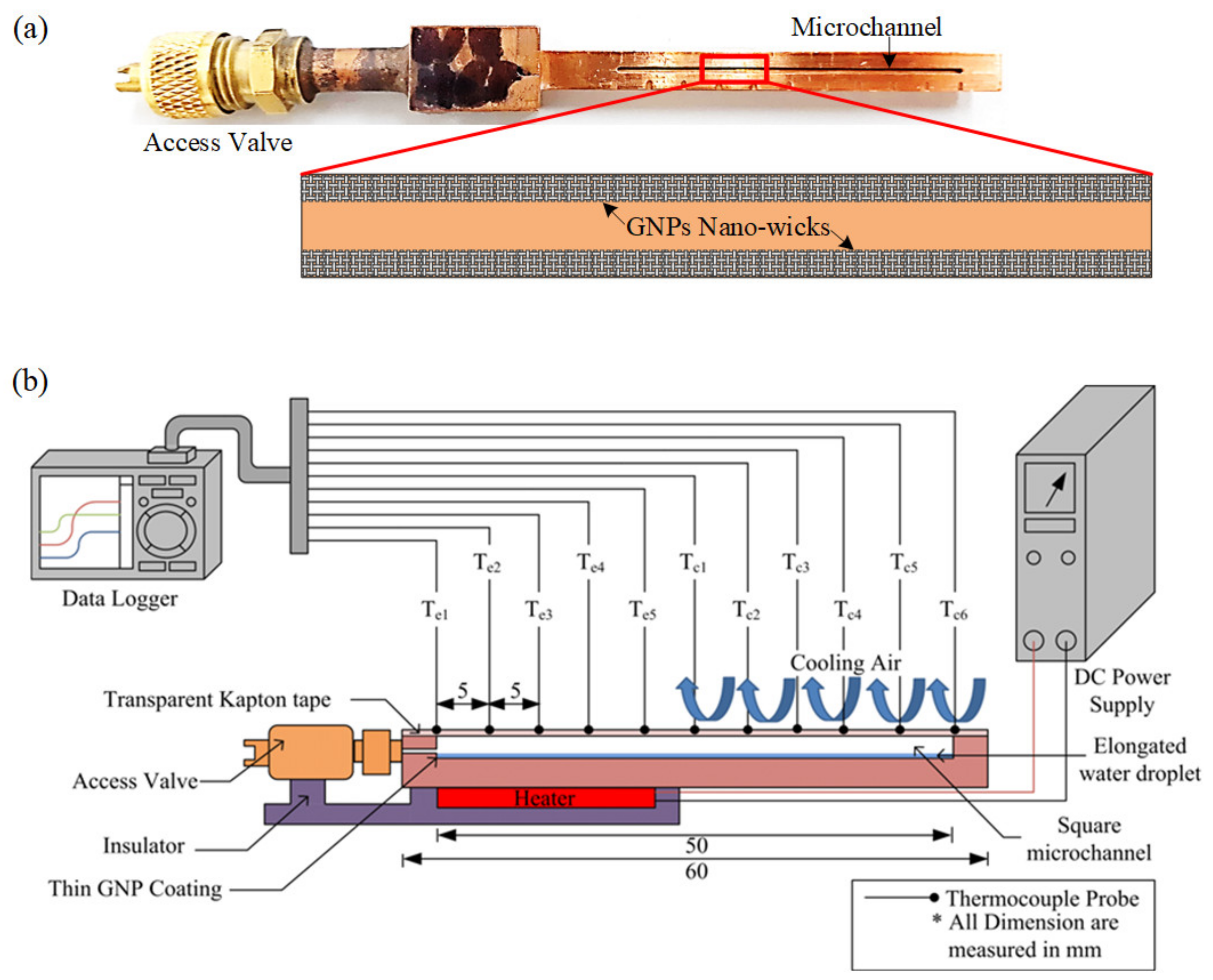
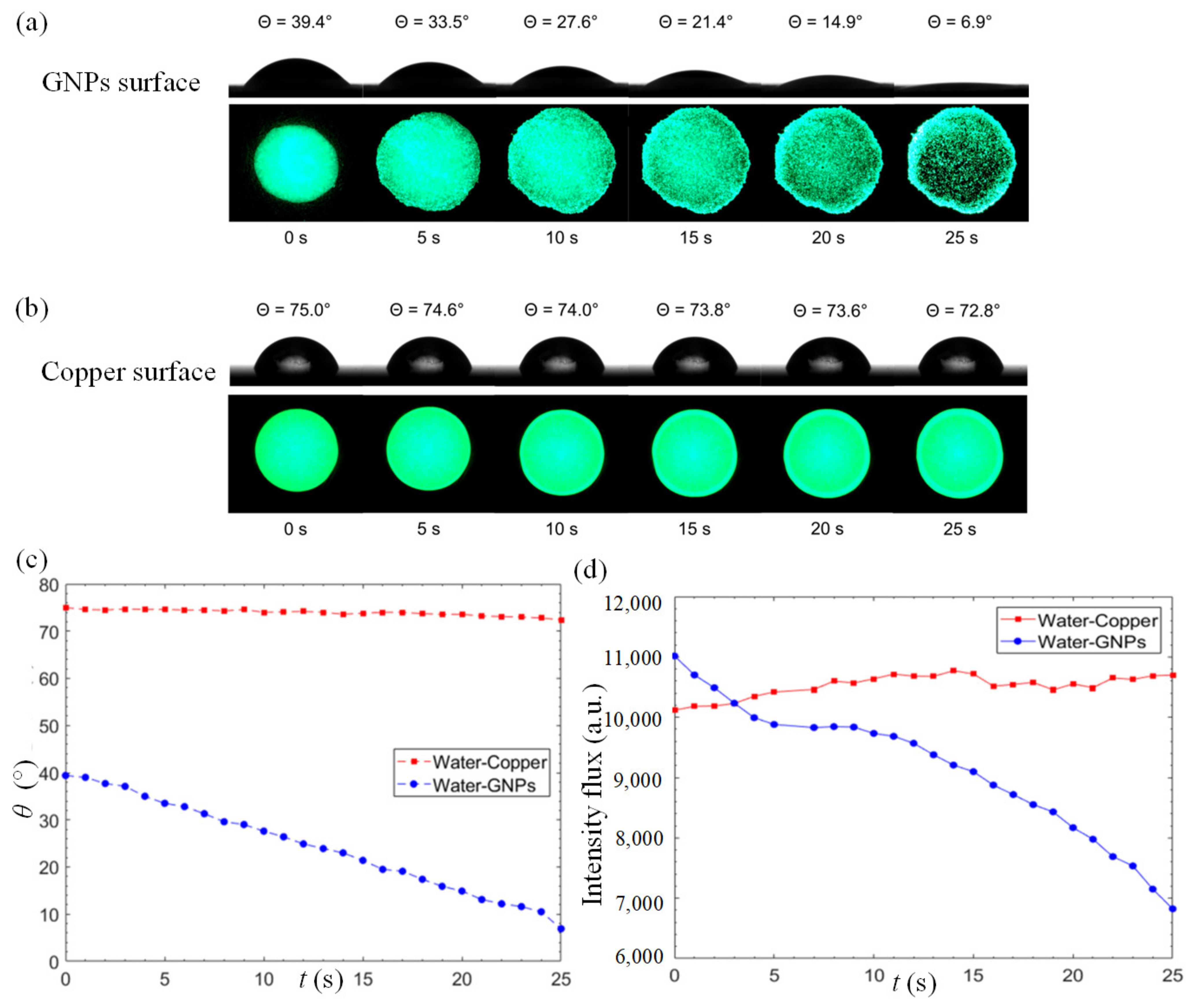
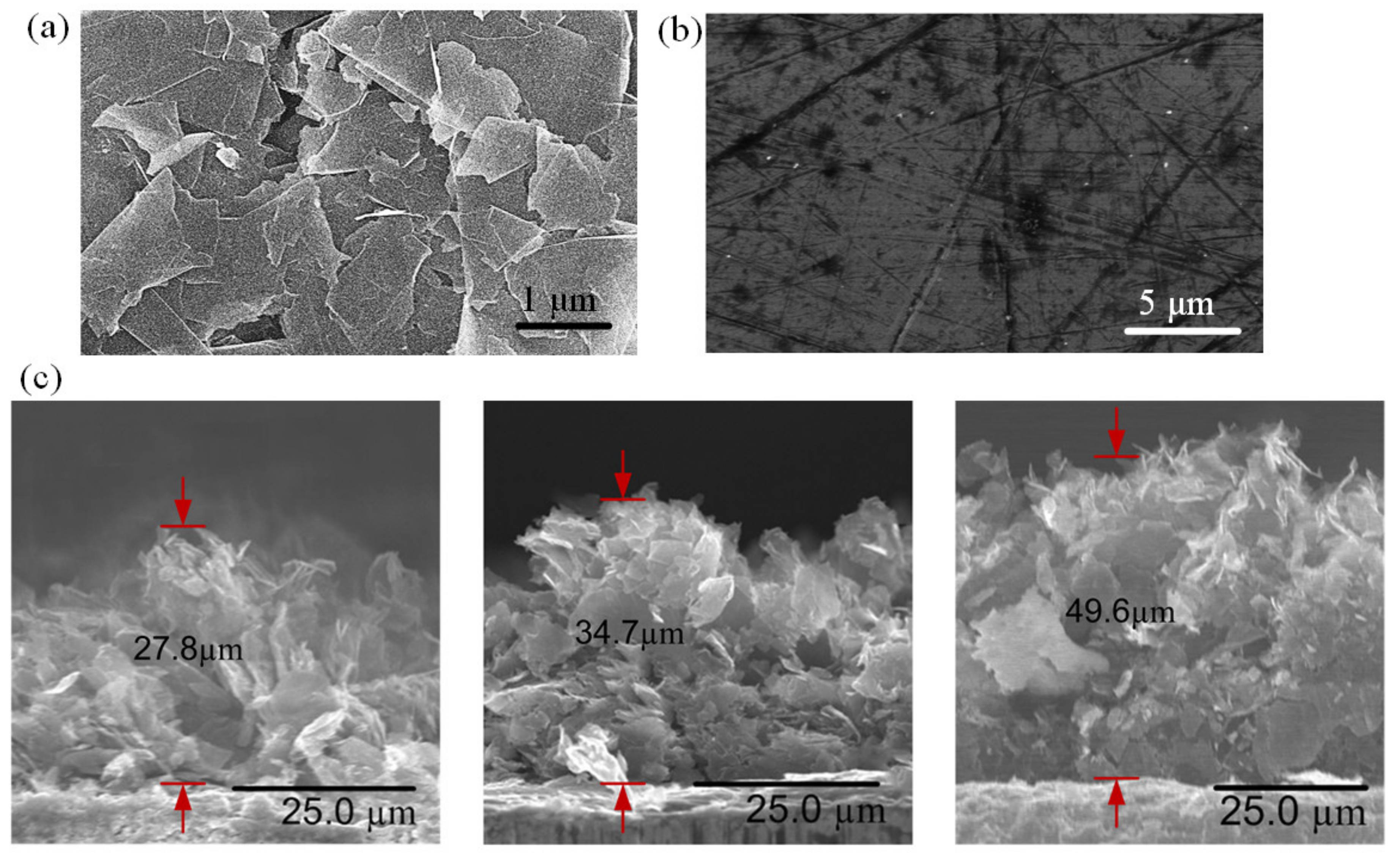
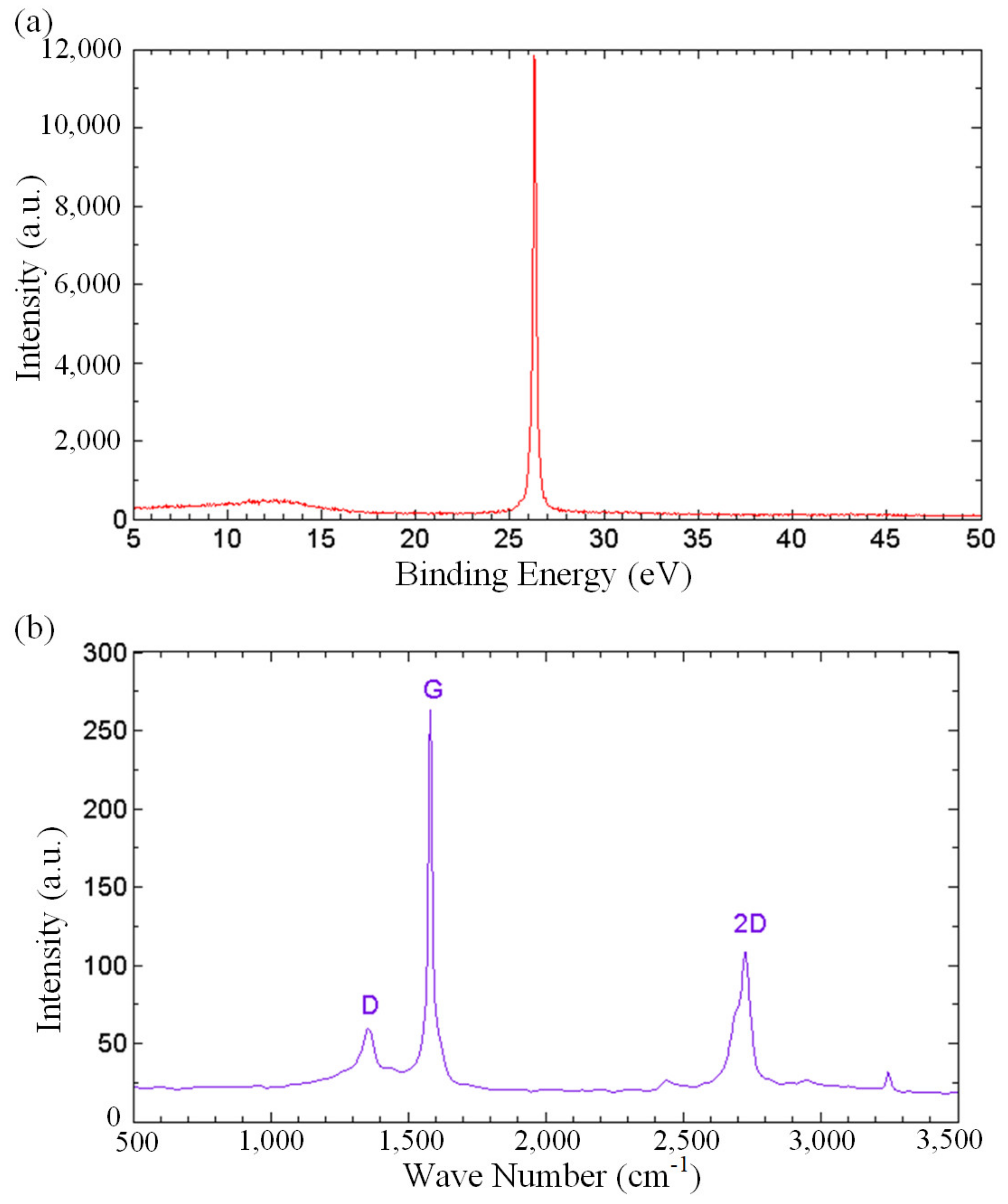
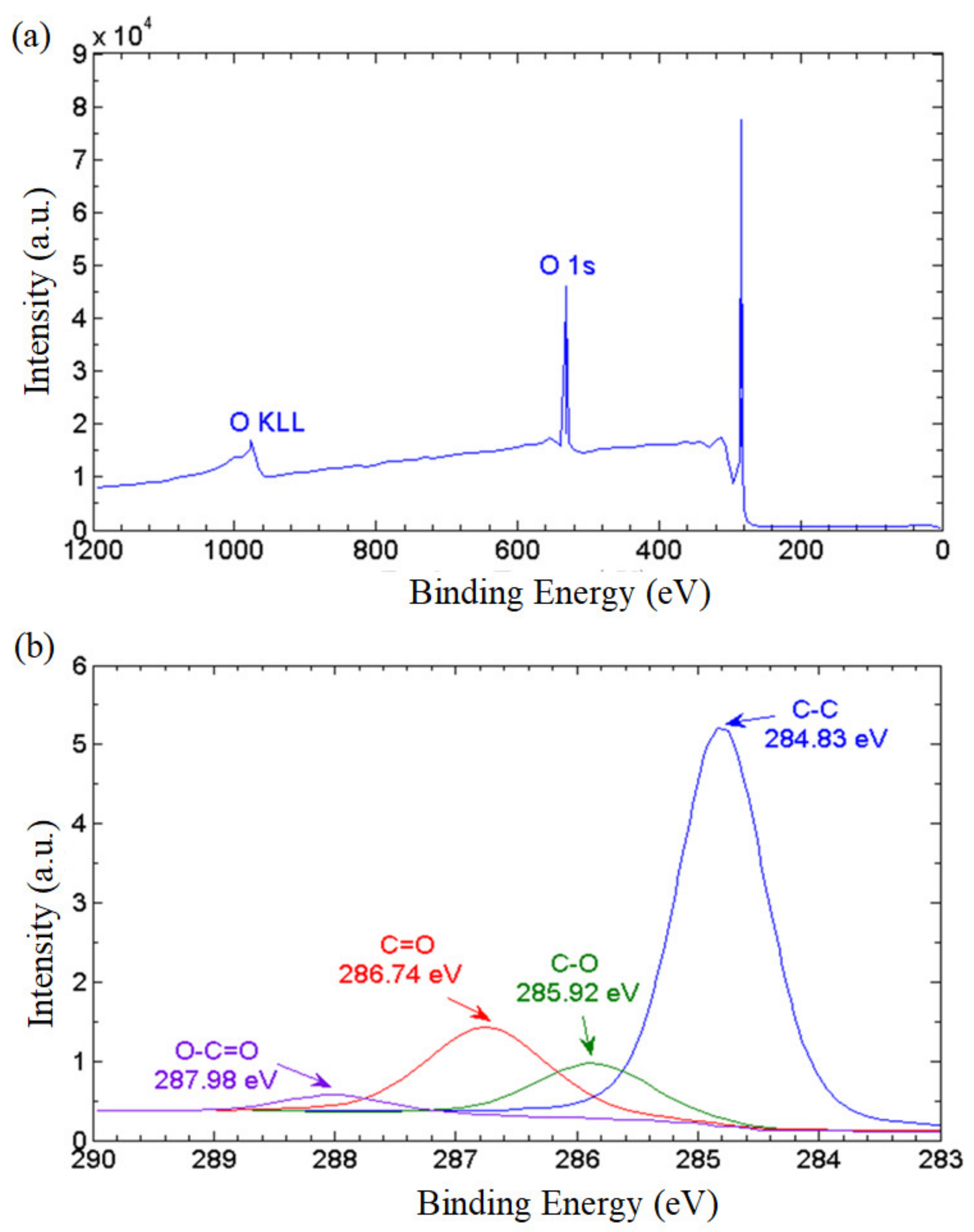
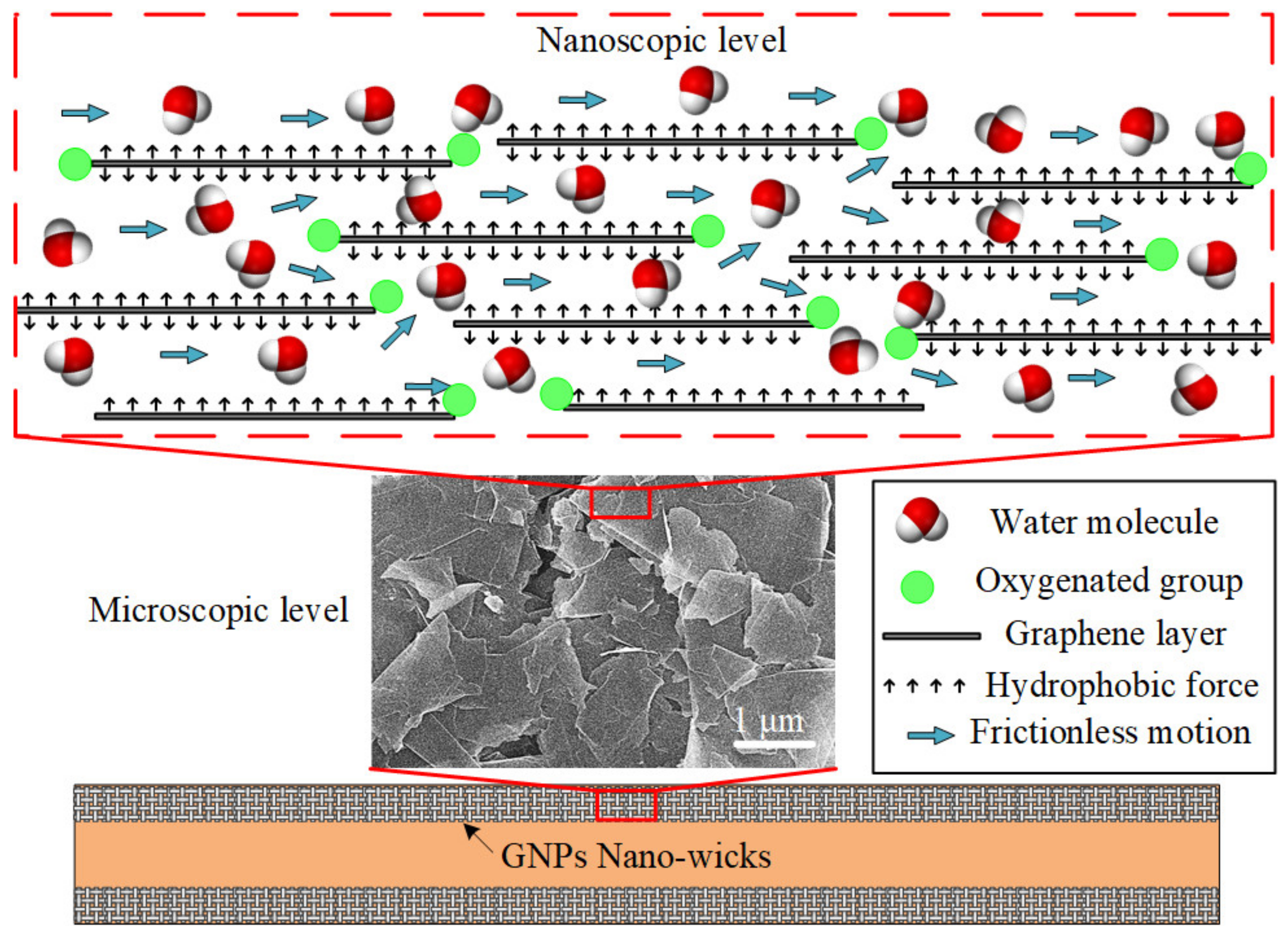
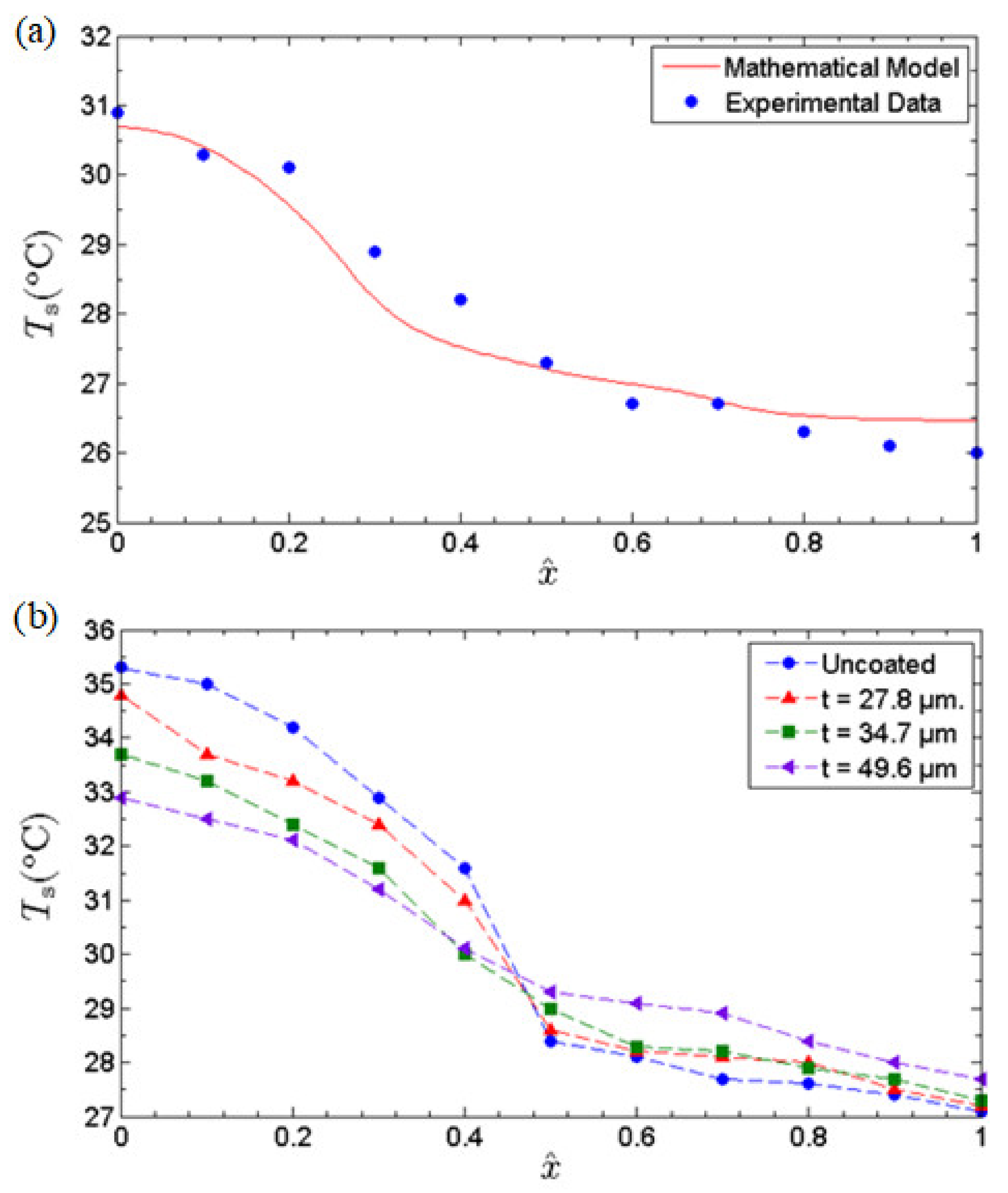
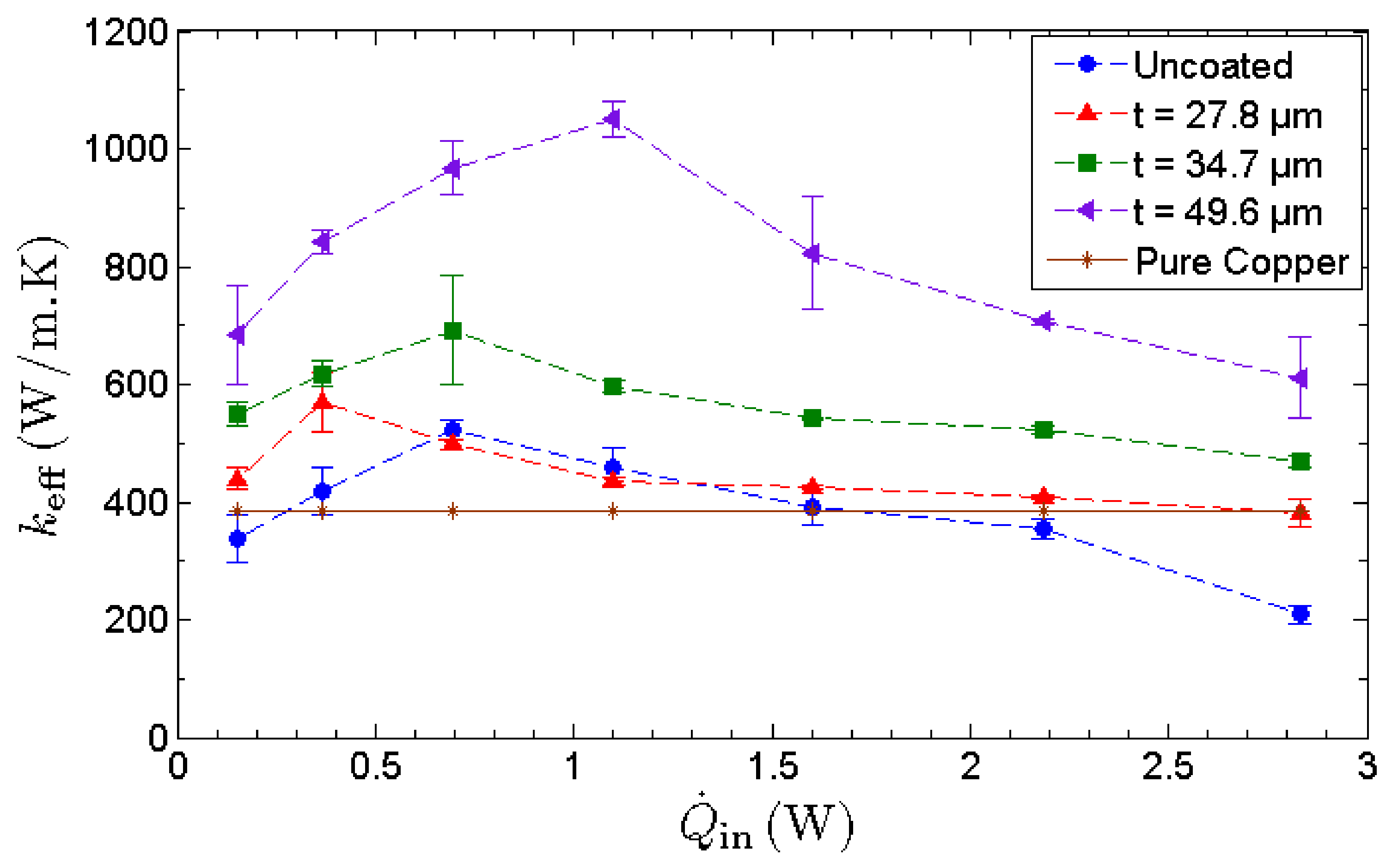
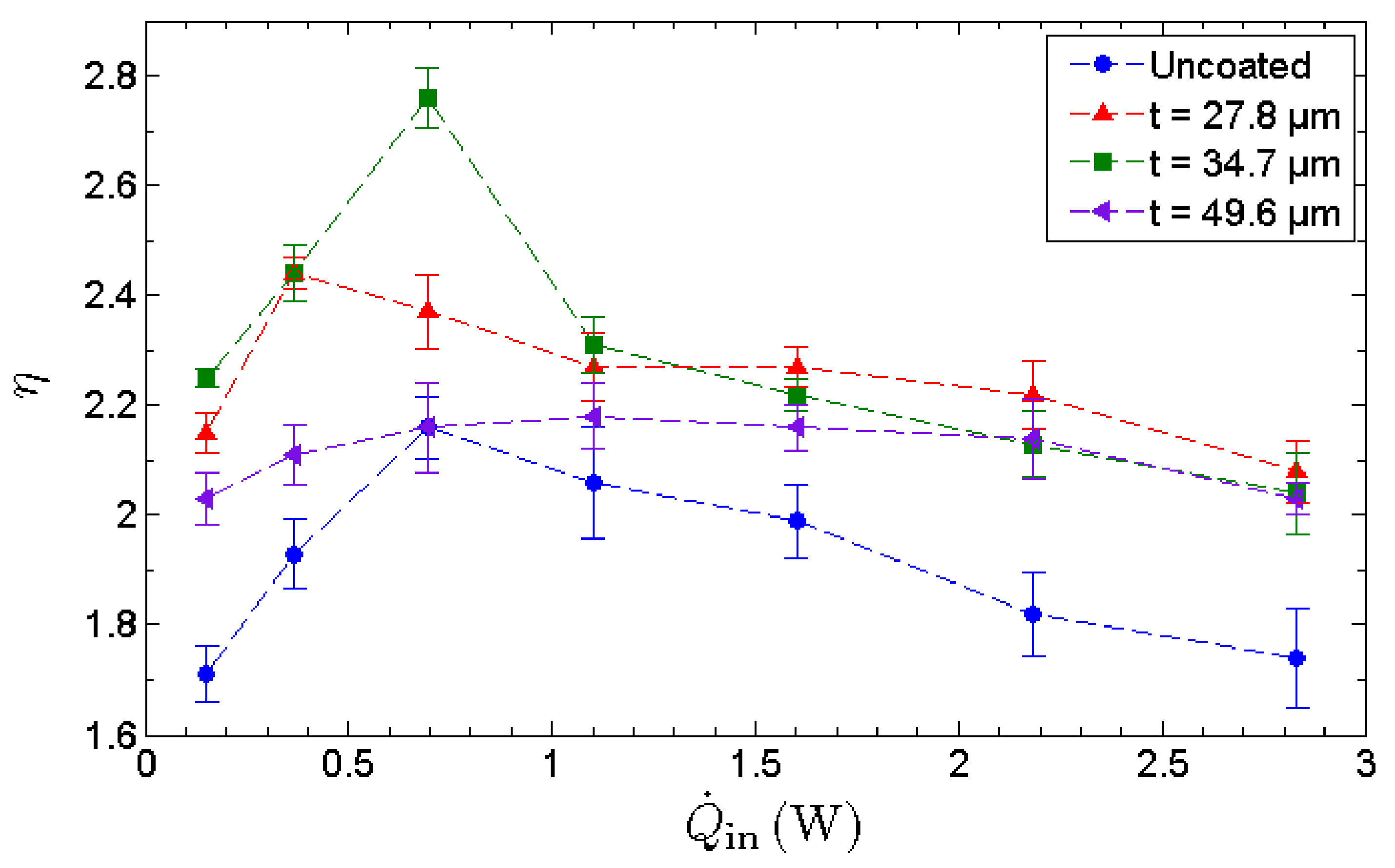
Disclaimer/Publisher’s Note: The statements, opinions and data contained in all publications are solely those of the individual author(s) and contributor(s) and not of MDPI and/or the editor(s). MDPI and/or the editor(s) disclaim responsibility for any injury to people or property resulting from any ideas, methods, instructions or products referred to in the content. |
© 2023 by the authors. Licensee MDPI, Basel, Switzerland. This article is an open access article distributed under the terms and conditions of the Creative Commons Attribution (CC BY) license (https://creativecommons.org/licenses/by/4.0/).
Share and Cite
Gan, J.S.; Hung, Y.M. Remarkable Thermal Performance Enhancement of Micro Heat Pipes with Graphene-Nanoplatelet Nano-Wicks. Nanomaterials 2023, 13, 232. https://doi.org/10.3390/nano13020232
Gan JS, Hung YM. Remarkable Thermal Performance Enhancement of Micro Heat Pipes with Graphene-Nanoplatelet Nano-Wicks. Nanomaterials. 2023; 13(2):232. https://doi.org/10.3390/nano13020232
Chicago/Turabian StyleGan, Jie Sheng, and Yew Mun Hung. 2023. "Remarkable Thermal Performance Enhancement of Micro Heat Pipes with Graphene-Nanoplatelet Nano-Wicks" Nanomaterials 13, no. 2: 232. https://doi.org/10.3390/nano13020232
APA StyleGan, J. S., & Hung, Y. M. (2023). Remarkable Thermal Performance Enhancement of Micro Heat Pipes with Graphene-Nanoplatelet Nano-Wicks. Nanomaterials, 13(2), 232. https://doi.org/10.3390/nano13020232






